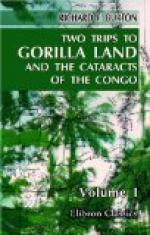In 1856, the same gentleman, who had taken the chief part in the first publication, made an able abstract and a comparison with the Grebo and Mandenga tongues ("Western Africa,” part iv. chap. iv.). M. du Chaillu further abridged this abridgement in his Appendix without owning his authority, and in changing the examples he did all possible damage. In the Transactions of the Ethnological Society of London (part ii. vol. i. new series), he also gave an abstract, in which he repeats himself. A “vocabulaire de la langue Ponga” was printed in the “Memoires de la Societe Ethnologique,” tome ii., by M. P. H. Delaporte.
The other publications known to me are:—
1. The Book of Proverbs, translated into the Mpongwe language at the mission of the A. B. C. F. M., Gaboon, West Africa. New York. American Bible Society, instituted in the year MDCCCXVI. 1859.
2. The Books of Genesis, part of Exodus, Proverbs, and Acts, by the same, printed at the same place and in the same year.
The missionary explorers of the language, if I may so call them, at once saw that it belongs to the great South African family Sichwana, Zulu, Kisawahili, Mbundo (Congoese), Fiote, and others, whose characteristics are polysyllabism, inflection by systematic prefixes, and an alliteration, the mystery of whose reciprocal letters is theoretically explained by a euphony in many cases unintelligible, like the modes of Hindu music, to the European ear.[FN#16] But they naturally fell into the universally accepted error of asserting “it has no known affinities to any of the languages north of the Mountains of the Moon,” meaning the equatorial chain which divides the Niger and Nile valleys from the basin of the Congo.
This branch has its peculiarities. Like Italian—the coquette who grants her smiles to many, her favours to few—one of the easiest to understand and to speak a little, it is very difficult to master. Whilst every native child can thread its way safely through its intricate, elaborate, and apparently arbitrary variations, the people comprehend a stranger who blunders over every sentence. Mr. Wilson thus limits the use of the accent: “Whilst the Mandenga ("A Grammar of the Mandenga Language,” by the Rev. R. Maxwell Macbriar, London, John Mason) and the Grebo ("Grammar,” by the Right Rev. John Payne, D.D. 150, Nassau Street, New York, 1864), distinguish between similar words, especially monosyllables, by a certain pitch of voice, the Mpongwe repel accent, and rely solely upon the clear and distinct vowel sounds.” But I found the negative past, present, and future forms of verbs wholly dependent upon a change of accent, or rather of intonation or voice-pitch, which the stranger’s ear, unless acute, will fail to detect. For instance, Mi Taund would mean “I love;” Mi taunda, “I do not love.” The reverend linguist also asserts that it is almost entirely free from guttural and nasal sounds; the latter appeared to me as numerous and complicated as in the Sanskrit. Mr. Wilson could hardly have had a nice ear, or he would not have written Nchigo “Ntyege,” or Njina “Engena,” which gives a thoroughly un-African distinctness to the initial consonant.




